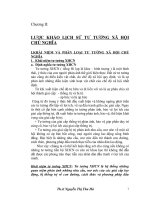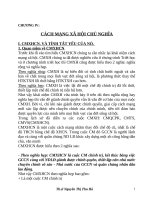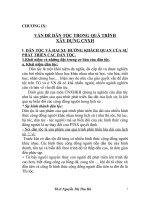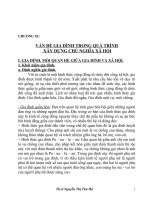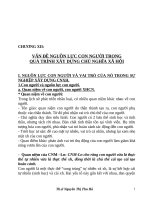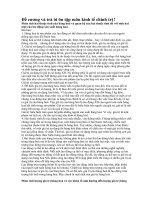ÔN TẬP ĐỢT 2-ANH 6
Bạn đang xem bản rút gọn của tài liệu. Xem và tải ngay bản đầy đủ của tài liệu tại đây (118.13 KB, 3 trang )
<span class='text_page_counter'>(1)</span><div class='page_container' data-page=1>
<b>ÔN TẬP ĐỢT 2</b>
<b>YÊU CẦU: Học sinh làm bài ra vở và chụp ảnh gửi vào zalo 0392708365 (Cô Vũ </b>
<b>Ngọc Ánh) trước ngày 24/2/2020</b>
<b>A. GRAMMAR</b>
<b>1. The past simple tense ( Thì quá khứ đơn)</b>
<b>a. Form</b>
Normal Verb To be
(+
)
S + Ved You, we, they + were
I, he, she, it + was
(-) S + didn’t + V-inf You, we, they + weren’t
I, he, she, it + wasn’t
(?) Did + S + V-inf? Were + you, we, they?
Was + I, he, she, it?
Ex: <i>I watched TV last night</i>
<i> I didn’t watch TV last night</i>
<i> Did you watch TV last night?</i>
<b>b. How to change infinitive verbs into past form </b>
Động từ ở thì q khứ được chia làm 2 loại: có quy tắc và bất quy tắc.
- Đối với động từ có quy tắc, khi chuyển sang dạng quá khứ, ta thêm đuôi “ed”.
Ex: <i>help => helped, want => wanted </i>
- Nếu động từ kết thúc bằng nguyên âm + y, ta thêm đuôi “ed" như bình thường.
Ex: <i>play => played, stay => stayed</i>
- Nếu động từ kết thúc bằng phụ âm + y, ta đổi y <i>=></i> ied
Ex: <i>cry => cried, study => studied </i>
- Đối với động từ bất quy tắc: tra dạng quá khứ trong Bảng động từ bất quy tắc.
<b>c. Use</b>
Dùng để diễn tả hành động đã xảy ra và kết thúc hoàn toàn trong quá khứ. (Trong câu
thường có các trạng ngữ chỉ thời gian)
Ex: <i>She worked for Thang Long Company last year. Now she is working for the BBC</i>
<i>Company. </i>
<b>d. Signals</b>
- yesterday (hơm qua), at that moment (lúc đó), last night (tối hôm qua)
- last + week/ month/ year: tuần/ tháng/ năm vừa rồi
- Khoảng thời gian + ago (cách đây ...): two days ago (cách đây 2 ngày), three years ago
(cách đây 3 năm)
- In + năm: in 2000 (năm 2000)
</div>
<span class='text_page_counter'>(2)</span><div class='page_container' data-page=2>
Câu mệnh lệnh dùng khi ta muốn yêu cầu ai đó làm việc hoặc đừng làm việc gì đó
<b>Form: </b> <b>(+) V! </b>
<b> (-) Don’t + V! </b>
Ex: <i>- Look at the board! </i>
<i> - Don’t play with the dog! </i>
<b>B. PRACTICE</b>
<b>Exercise 1: Change the verbs into simple past form.</b>
No. Present form Past form No. Present form Past form
1 Be 6 Read
2 Play 7 Listen
3 Build 8 Learn
4 Do 9 Drink
5 Bring 10 Give
<b>Exercise 2: Choose the words to complete the sentences using past simple tense. </b>
<i><b>teach cook want spend ring be sleep study </b></i> <i><b>go write</b></i>
1. She ___________ out with her boyfriend last night.
2. Laura ___________ a meal yesterday afternoon.
3. Mozart ___________ more than 600 pieces of music.
4. I ___________ tired when I came home.
5. The bed was very comfortable so they ___________ very well.
6. Jamie passed the exam because he ___________ very hard.
7. My father ___________ the teenagers to drive when he was alive.
8. Dave ___________ to make a fire but there was no wood.
9. The little boy ___________ hours in his room making his toys.
10. The telephone ___________ several times and then stopped before I could answer it
<b>A. Ngữ pháp</b>
<b>1. Wh –question</b>
<b>Question word</b> <b>It is used to talk about...</b>
When (Khi nào) The time
How (Như thế nào, bằng cách nào) The manner
How many/ often(Bao nhiêu/ Bao lâu 1 lần) The number/ repetition
What (Cái gì) The thing
Where (Ở đâu) The place
Who (Ai) The person
</div>
<span class='text_page_counter'>(3)</span><div class='page_container' data-page=3>
<b>2. Conjunctions </b>
Từ nối được sử dụng để kết nối các từ và các ý tưởng với nhau.
<b>and: và</b>
E.g: <i>Most children like cartoons and comedies.</i>
<b>but: nhưng</b>
<b>because: bởi vì</b>
E.g: <i>Because I was ill, I didn’t go to school.</i>
<i> I didn’t go to school because I was ill.</i>
<b>although: mặc dù</b>
E.g: <i>Although I was ill, I went to school.</i>
<b>so: nên</b>
E.g: <i>I enjoy sports, so I pend a lot of time outdoors.</i>
<b>B. Bài tập</b>
<b>1. Match the questions (A) and the answers (B).</b>
<b>A</b>
<b>B</b>
31. How often do you watch football on TV?
32. Where is Hollywood?
33. What channel is the film on?
34. What time is the cartoon on?
35. What is the name of your favourite TV
programme?
36. Why do you like the programme?
37. How many hours a day do you watch?
38. Who is the director of the film?
39. When did John Logie Baird make the first TV
set?
40. Why do you like cartoon?
a. In 1926.
b. It’s on VTV3.
c. In California, USA.
d. Because it’s very exciting.
e. About two hours a day.
f. Because they are colourful
and funny.
g. It’s Steven Spielberg.
h. It’s at 7.30 pm.
i. It’s the science programme.
j. Twice a week. Usually at
weekend.
<b>2. Use the conjunction at the end of each group to connect the </b>
<b>sentences.</b>
1. We turned to The Movie Channel. We wanted to watch Pinocchio.
(because)
2. My sister is a weatherwoman. My father is a newsreader. (and)
3. I am interested in the history of television. I've read a lot of books
about it. (so)
4. I love films. I don't like watching them on television. (but)
</div>
<!--links-->

